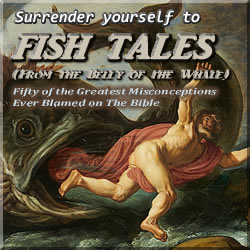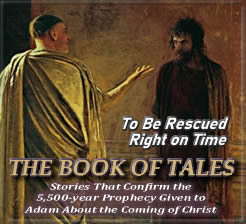Raptures, Eagles, and Dead Bodies
Questions Concerning Those Who Will be Left Behind
ABSTRACT: When it comes to creating a great biblical misconception, it always helps to have the cooperation of Christians the world over. However, to create a colossus of a misconception, you don’t just enlist believers in your cause; you enlist unbelievers, too. In the case of our latest misconception, then, you not only communicate your tale from every pulpit and microphone, but you also send it out via the secular media—through pop songs, popular books, and blockbuster movies. Take, for example, the sensational tale of two men in a bed, and two women at the mill, in which one is said to be taken, while the other is left behind. According to tradition, this scenario speaks of the Rapture of the Church. On one hand, you have believers in Christ who couch this tale in the context of the Apostle Paul’s comments regarding a “catching away in the clouds, to meet the Lord in the air.” And on the other hand, you have unbelievers who still see this unlikely story as a compelling mystery along the lines of the spine-tingling tales of alien abduction. In either case, you have a story, which despite its far-fetched elements, that grows and grows with each passing year. Unfortunately, the end result of all this well-meaning publicity is a complete check-out in terms of the actual context in which the verses appear that have Jesus speaking of those who will be taken and those who will be left behind. Because should one ever take the time to examine the context of the words of the Lord Himself, we’d be shocked indeed to find that not only is there a bed and a mill involved, but there is also the completely ignored aspect of this story, which just happens to involve eagles, or to be more precise, vultures… and dead bodies, or to be more precise, corpses fallen in battle…
ONE WILL BE TAKEN, and one will be left behind. On that day—the day of all days—the moment that all Christians have desired for so long will finally be upon us. To some, it will be a wonderful day, to others, a dreadful day. What day are we talking about? Why, of course, it’s the Rapture of the Church. Speaking of that day, Jesus said:
I say to you, in that night there will be two men in a bed; one will be taken and the other will be left behind. There will be two women grinding at the mill; one will be taken, and the other left behind. So watch out, because you don’t know the day your Lord is coming… Matthew 24:40-42; Luke 17:34-35
The Rapture—the day we’ve all heard about so much about. Streaming forth in every medium of communication known to mankind, the story is told again and again, in sermon after sermon, song after song, book after book, and movie after movie. One is taken; the other is left behind. Considering all the press this story receives, it’s no wonder that most Christians the world over accept that Jesus was talking about the Rapture of the Church. Even more amazing is how this story has captured not only the imagination of Christians but non-Christians as well.
Not because non-Christians are buying into the story, as though they actually believe it will ever happen, but because they find the story so intriguing at its most basic level. In other words, although completely far-fetched—in their view—it still makes for a compelling yarn, much akin to the equally far-fetched scenarios involving alien abductions. Great drama, after all, is great drama, right? In its most basic form, then, the story runs as follows.
The world and all its inhabitants are going about their humdrum lives, going through life without a thought for tomorrow, neither concerned about the direction of their lives nor the consequences their careless lifestyle will bring upon them. Then, suddenly, like a bolt of lightning from the sky, millions of people the world over vanish into thin air. As a result of this inexplicable disappearance of so many people—as the story goes—countless aircraft, boats, and automobiles are left without pilots or drivers, causing many to veer off course and crash.
All this, say the Christian ministers of truth, will occur because that will be the day of the Rapture of the Church, of which the Apostle Paul spoke to us about in The First Book of Thessalonians:
For the Lord Himself will descend from Heaven with a loud command, with the voice of an archangel and the trumpet of God, and the dead in Christ will be the first to rise. After that, we who are alive and remain will be caught up together with them in the clouds to meet the Lord in the air. And so we’ll always be with the Lord… First Thessalonians 4:16-17
Certainly, if one is a true believer in the message of The Bible, it’s hard to argue with the preceding words of Paul. Clearly, Paul believes there’s going to be a future event that involves a “catching away in the clouds,” and, based on these verses, at least, it sure sounds a lot like a Rapture to me. The only problem: The verses where Jesus supposedly talked about the Rapture of the Church and those where Paul talked about a meeting in the air with the Lord are actually describing two completely different events.
“Whoa, whoa, whoa; wait just a second!” you might exclaim. “What are you saying?”
“I’m saying, the verses in question, in which Jesus spoke of two men and two women, of which only one is taken and the other left behind, is not—I repeat, is not—speaking of the same event described by Paul.”
“But how can that be?” you may ask. “Are you saying you don’t believe in the Rapture?”
To which I’d reply: “That’s not at all what I’m saying. Of course I believe there’s going to be a Rapture of the Church.”
And I do so because when I study The Bible as a whole I notice that God is, above all, a God Who repeats Himself. By that I mean that what God does better than anything else is to lay down patterns of His behavior in such a way that an onlooking world can discern a divine blueprint of the ages from these patterns of history. So, en route to addressing the issue of our present misconception, let’s first address this idea of God’s pattern of behavior, and once we do, I believe it’ll be much easier to understand my final verdict in this matter.
Story Continues Below
Says Richard Price—the founder and CEO of Academia.edu—on his podcast In Depth With Academia:
Fish Tales (From the Belly of the Whale): Fifty of the Greatest Misconceptions Ever Blamed on The Bible is:
To hear Price’s book review of Fish Tales (From the Belly of the Whale), CLICK HERE.
To hear Kent and Zen Garcia talk about correcting biblical misconceptions, from October 28, 2021, CLICK BELOW.
Story Continues From Above
CONCERNING THE age-old question of whether the Church will be raptured before, during, or after the so-called “Great Tribulation,” there are certainly as many answers supporting the various positions as there are questions. Of course, this is nothing new when trying to penetrate such mysteries, because, by God’s design, the prophecies of The Bible have always been impossible to fully comprehend until after they’ve been fulfilled. Then, and only then, can we really be sure what they meant to say all along.
The only sensible thing to do, then, is to look at the prophecies of Scripture with one eye on the future and the other eye on the past. In other words, only by looking at how God has rescued His people in the past can we ever hope to anticipate what He might do in the future. With that in mind, let’s turn to that history to see how it might shed light on this future event we know of today as the Rapture of the Church.
Of the many events in the history of God’s deliverance of His people, the ones that stick out in the minds of most people are those of Noah, his family, and the Great Flood; of Moses, the Israelites, and the Exodus out of Egypt; and of Lot, his family, and the destruction of Sodom and Gomorrah. In every instance, God’s rescue effort of His chosen ones follows a strict pattern, consistent from event to event.
Before God’s judgment is unleashed upon those who resist the call to amend their ways, those who choose to conform are first “evacuated,” then judgment falls. Noah and his family enter the safety of the ark before the Great Flood pours forth its fury upon the Earth. Moses and the Israelites escape through the parted Red Sea before it collapses and destroys Pharaoh’s pursuing army. And Lot and his family are escorted out of Sodom before fire and brimstone rain down on the cities of doom. Never once are the chosen ever subjected to the same circumstances that are meted out upon the recipients of God’s wrath.
In the same way, according to God’s timeless pattern, we can and should expect a similar thing to occur in His rescue of the Church before the unleashing of those dark days, said to be such that never before or ever will again be days so terrible and fierce as in the days of the Great Tribulation. (Matthew 24:21)
Should anyone doubt such a verdict, let’s keep in mind that whereas previous recipients of God’s mercy were said to be chosen of the Lord, the Church is unique among these examples, in that she alone is called the Bride, or Body, of Christ. One can only imagine the mindset of those who’d think that Christ’s Bride or Body would ever be subjected to the events predicted to occur in the Great Tribulation. As Peter explained it: “For Christ suffered for sins once for everyone, the righteous for the unrighteous, to bring you to God.” (First Peter 3:18) Notice the operative word here—once.
So, if Christ was beaten and suffered for our sakes, “once for everyone,” then His Bride, His Body, will undergo just one baptism by fire, which historians will tell you constitutes the seven stages of the Church Age—represented by the seven churches of Asia, as described by John the Revelator. It’s there that John predicted the Church’s future suffering that Christ Himself endured and that He predicted for those who loved Him, even to the point of death.
But hold fast until I return. And to those who overcome all this, and whoever keeps My word to the very end, to them will I grant authority over the nations, and they’ll rule them with a rod of iron, as vessels that are shattered into pieces, just as I’ve received the same authority from My Father… Revelation 2:25-28
It’s also important to note, in the context of the timing of the Rapture, that John, in Revelation—as a type of the Church—sees a door open in Heaven after which a voice like a trumpet says to him, “Come up here, and I’ll show you the things which must come to pass after all this.” (Revelation 4:1) That is to say, John is caught up to Heaven—again, as a type of the Church—both of which undergo a mysterious “catching away.”
When?
After the seven churches of Asia have run their course, which are—I repeat—to be equated with the seven historical stages of the Church Age. Once these stages are complete, then there’s one who’s caught up to Heaven, followed by the unleashing of the sevens seals of judgment that are famously described throughout the rest of The Book of Revelation.
All this needs to be seen in context, then—the pattern of God’s chosen being evacuated before judgment is unleashed, together with John the Revelator being caught up to Heaven, as a type of the Church, before the seven seals of judgment are opened.
SO, NOW THAT I’ve conveyed a scriptural foundation for my belief that there’ll be a Rapture and that it’s to take place before the Great Tribulation, some of you may still be wondering: Then why don’t you believe Jesus was talking about the Rapture when He stated that certain ones would be taken, while others would be left behind?
Well, as usual, I do so because of my acute awareness of the three laws of disinformation I keep harping on. How do they apply in this case?
First, take an idea that’s firmly rooted in Scripture. In this case, we clearly have evidence for an event that sounds like the Rapture. In fact, Paul couldn’t be more explicit if he tried. To the Thessalonians he said, there will be “a meeting of the living and the dead in Christ with the Lord Himself in the air.”
Second, take a verse that seems to fit the pattern of Rapture references but which doesn’t—as we’ll shortly demonstrate—and then isolate it from all the others.
Third, having removed it from its context, repeat it ad nauseam as if it were the only verse in The Bible that has anything to say about said event.
And voilà, the result is a supposed warning to mankind about the irrevocable abruptness of the Day of the Lord, punctuated by a glorious Rapture of the faithful. Right?
Well, sure, that’s what you’d think were you to never take the time to read The Bible for yourself. Because if you did, you’d notice in Luke’s account, when Jesus told this story to His disciples, they asked Him: “But where are they being taken, Lord?” Then Jesus replied, “Wherever the bodies are, that’s where the eagles will be gathered.” (Luke 17:37)
And that’s when anybody with a lick of sense will say, “Whoa, wait just a darn second here? Bodies? Eagles? What happened to the part about meeting the Lord in the air?”
Then things get even more bizarre when we look into the original language from which The King James Bible is deriving this phrase. According to Strong’s Exhaustive Concordance, the words for “bodies” and “eagles” turn out to be nowhere near what most think of when they hear those words. According to every biblical translation other than the King James Version, this phrase actually reads: “Wherever the carcasses are, that’s where the vultures will be gathered.”
Two things instantly strike me in light of this added dimension to the story. First, the fact that The King James Bible provides a clue that this “catching away” is an earthly event, where “bodies and eagles are gathered,” should be enough to cause people to discard it as having anything to do with Paul’s description of what’s clearly an otherworldly event, where “we’ll be meeting the Lord in the air.”
And second, add to that our modern understanding that these bodies and eagles are really carcasses and vultures, and it becomes even more laughable that this event would persist in being associated with the Rapture of the Church, even by the most tolerant-minded of Christians.
No wonder the unbelieving world today, in our Internet age of instant information, considers the belief in an honest-to-goodness Rapture to be sheer madness. More tragic still, though, is how this new take on what was once considered rocked-ribbed Scripture has undermined even the Church’s view of what Paul intended for God’s people, when he first uttered these words concerning that day: “Therefore, encourage one another with these words.” (First Thessalonians 4:18)
So tell me: How encouraging are his words in light of the fact that the event spoken of in Matthew and Luke can no longer be understood in the same vein as Paul’s message of being caught up in the clouds to meet the Lord?
Fortunately for us, though, because there’s more than one book in it, The Bible’s overall perspective rescues us from such pessimism and doubt when we look beyond what the latch-isolate-and-repeat crowd insists is the whole truth and nothing but the truth so help them God.
IN CONCLUSION, we only have to ask a few questions to slay one of the most voracious of all disinformation monsters in the history of the Church. This monster insists that the story of certain ones being taken and others being left behind is a story of the Rapture, and because of the obvious contradictions stemming from such a belief, even the Church has succumbed to the notion that there might be no such thing as the Rapture.
In response to such monstrous ideas, we ask: If Jesus is predicting the Rapture of the Church, what are carcasses and vultures doing stinking up the place?
The answer, in light of new evidence, is: It’s clearly no Rapture at all, and in one fell swoop, that monster is vanquished.
As for the next question: So, if this event described by Jesus isn’t the Rapture, then what is it?
Oddly enough, the answer, in my view, is really quite simple. Simple, that is, if one has appreciated and accepted our previous train of thought regarding God’s habit—if we may call it that—of laying down predictable patterns throughout the history of the redemption of mankind. I say, oddly enough, because just as God is predictable in His way of doing things, Satan, as it turns out, is often just as predictable. But whereas God’s ways are predictable because He is, by nature, faithful and true to His word, the devil is predictable for very different reasons.
Satan is predictable because he’s nothing but a cheap, lowdown counterfeit artist who doesn’t have an original idea in his devious mind. As such, his age-old modus operandi is to take everything he sees God doing and to mimic it in a way that his behavior is a kind of mirror image of God’s. This mirror image, of course, is but a wretchedly dark imitation of God’s vibrantly bright image, much in the same way that modern scientific research has discovered the existence of dark matter, which co-exists with what could be called bright matter. While we can see one form of matter, the other form is invisible to the naked eye. So, just as scientists can only study dark matter by looking at the effect it has on the matter we can see, we’re able to detect Satan’s activities by interpreting the patterns of his covert behavior as they crop up throughout human history.
Examples of this have already been discussed in Reel One of Fish Tales. Wherever we’ve seen some of the most important activities of God, in revealing His faithfulness, the devil has been shown to have invaded the territory so that what was once understood as God’s revelation has become so confused that mankind is now convinced it’s the furthest thing from it. We’ve seen this with the story of Christ in The Zodiac, where what was intended to convey the celestial drama of divine redemption is now seen as either a fool’s game or a heretic’s playground. We’ve seen it in the case of Christmas, where what was supposed to teach mankind about the significance of Christ’s birth is now nothing more than a muddled confusion of that original truth.
And now, we’ve come to yet another example of this kind of camouflage tactic, in that while God speaks of His gathering together of His saints with Christ in a spectacular catching away, the devil, as that perennial angel of light, has made sure to conjure up his own version of a catching away. But whereas God’s catching away is to a place of light, restoration, and life, Satan’s is to a place of darkness, destruction, and death.
So, having come to the realization that Jesus isn’t talking about God’s gathering, in Matthew and Luke, but, rather, Satan’s gathering, we ask: To where are the people who’ve been taken being gathered?
To answer that, we must do some detective work, with our first clue being found in the very word being used in The King James Bible as “bodies,” which in every other translation is “carcasses” or, in some instances, “corpses.” According to certain scholars, these aren’t just any dead bodies. These dead bodies are those that have fallen in battle, which would explain why they’re attracting vultures. Had these been the bodies of most people, they would’ve been buried in a timely manner, according to the custom of the land. In this case, however, they’re not recovered before they become the targets of vultures, thus lending credence to the idea of their being casualties of war.
This leads to our final question, then: Where, exactly, is this field of battle to which these fallen ones have been gathered?
For that, we turn to our final clue, which comes by way of the word used for “gathered.” According to Strong’s, the Greek word meaning “to gather” comes from sunago, which not only provides the root word for the gathering described in Luke 17, but it’s also the word used in Revelation, as it is written:
These are the demonic spirits that perform signs and go out to all the kings of the Earth, to gather them for battle on the great day of God, the Almighty… And they gathered those kings in the place that in the Hebrew is called … Armageddon… Revelation 16:14, 16








